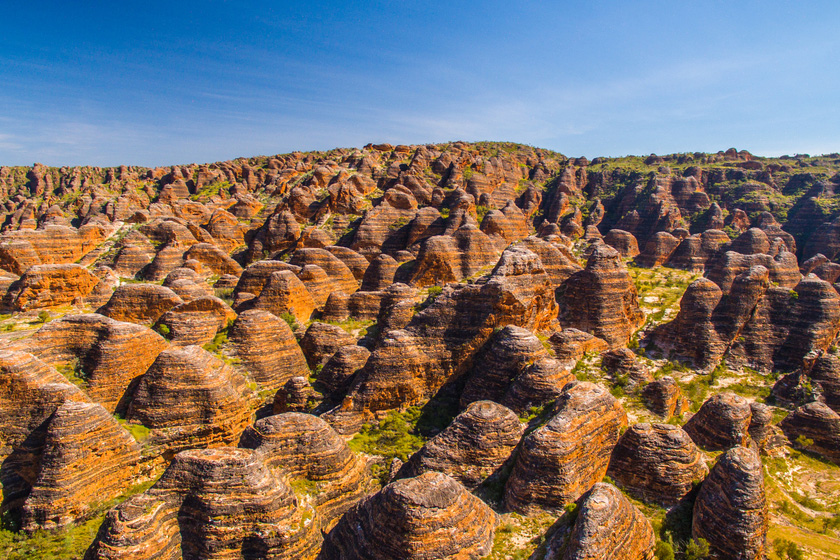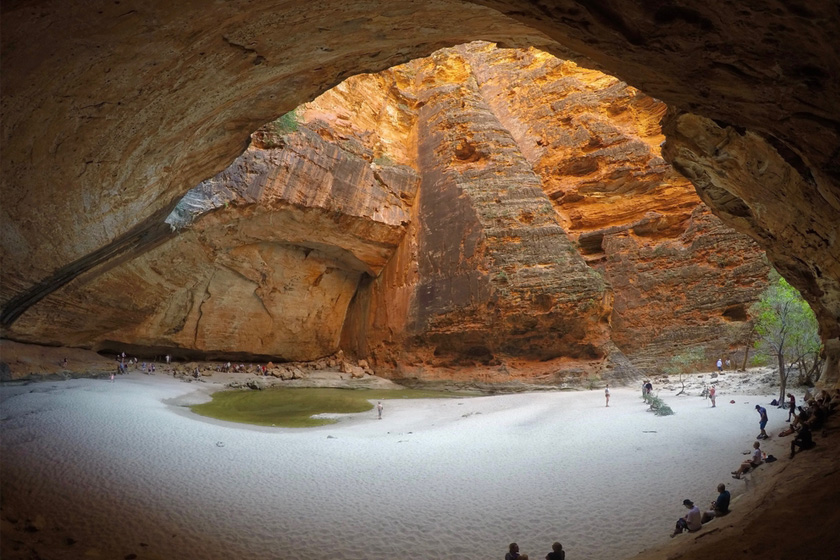Halls Creek, WA
Halls Creek lies on the edge of the Great Sandy Desert, at the junction of the Great Northern Highway and Duncan Road in the north west of the State. Halls Creek is the town closest to Purnululu National Park, the park of the famous Bungle Bungles. Also nearby is Wolfe Creek Crater, the second largest meteorite crater in the world. Tours of the crater and the Bungle Bungles are available from the town.
Visit the site of the first goldrush in Western Australia following the discovery in 1885. You can still find gold in the area, particularly around the old town site which is 16 kilometres east of Halls Creek and also features ruins of mud brick buildings and a small cemetery. Mineral exploration continues on a large scale in the area. The town is also the hub of a vast cattle industry.
Russian Jack, a goldmining character from the turn of the century who typified the hardy brand of early Halls Creek pioneers, has been immortalised in the town’s main street. The bronze statue depicts him in the act of pushing his sick friend in a wheelbarrow over 300 kilometres to Halls Creek in search of medical attention.
Halls Creek services the tourist market with a hotel, motel, caravan park and two roadhouses.
Drive in or fly over?
There are two ways to encounter the Bungle Bungle: by four-wheel drive, or by air. For advanced four-wheel drivers the Bungle Range offers a perfect wilderness adventure and an unforgettable camping site. You’ll find the turnoff to Purnululu National Park 250 kilometres – or around five hours – south of Kununurra, or 109 kilometres north of Halls Creek -Â around four hours drive.
Both camping spots there – Walardi or Kurrajong -Â have simple camping facilities. Most people camp there for a few days at least, so pack plenty of supplies! Take advantage of some the spectacular walks in the area. If you have a couple of days, go exploring in Picaninny Creek and Gorge, a spectacular walk not for the faint-hearted. Another wonderful walk is Echidna Chasm, on the northern side of the park.
The characteristics of the park fall neatly into two areas, north and south. The south, where the Bungle Bungle towers are, is best surveyed in the morning for full light-show effect. The north shows its best face in the afternoon.
The best time of year to visit the Bungle Bungle Range is well into the dry season, from April to October. Extreme weather makes access roads impassable outside of these times, and that’s when it’s time to take to the air. Some believe that flying offers the best Bungle Bungle experience regardless of the time of year. Scenic flights leave from Halls Creek or Kununurra, and gave an ideal view of this mystical landscape, sweeping effortlessly over the earthen towers of russet, black and moss-green.
Nature’s creation
The Bungle Bungle range is a stunning collection of beehive style geological formations arrayed in alternating bands of orange, black and green, in Purnululu National Park, 250 kilometres south of Kununurra, in the Kimberley, Western Australia. The area has been inscribed on the World Heritage List in 2003 for its outstanding natural heritage values.
While the reef is ancient, dating back hundreds of millions of years, locals kept it a secret and so the Bungle Bungle or Purnululu (meaning sandstone in the local Aboriginal Kija tongue) was not discovered by the wider world until the 1980s.
The hypnotically beautiful formations were formed by 20 million years of erosion and river movements. They are a combination of sandstone, and conglomerates (pebbles and boulders fixed together by finer material). Back when active faults were shaping the landscapes these sedimentary formations were dumped onto the Ord Basin, some 375 million years ago. The dome shapes are caused by natural erosion and uplift over 20 million years. The darker bands are more porous rock, which lets water move through and creates a dark algal growth. The domes are more fragile than they look. While the sandstone is held in place by overlying rock it is easily eroded, as revealed by the rounded tops.
The land is also rich in Aboriginal culture, being the site of indigenous art and sacred burial grounds. Wallabies, euros, and more than 130 bird species dwell in the park, including rainbow bee-eaters and flocks of beautiful wild budgerigars.
A natural buzz
The Bungle Bungle Range, in Purnululu National Park, is one of the most fascinating geological landmarks in Western Australia.
From an aircraft, the Bungle Bungle Range is an imposing sight. The orange and black stripes across the beehive-like mounds, encased in a skin of silica and algae, are clearly visible as you approach from the south. As you sweep further over the range a hidden world of gorges and pools is revealed, with fan palms clinging precariously to walls and crevices in the rocks.
Although the Bungle Bungle Range was extensively used by Aboriginal people during the wet season, when plant and animal life was abundant, few Europeans knew of its existence until the mid 1980s. The area has been a national park since 1987 and its unique appearance has captured the public imagination.
The park, which is open only between April and September, offers a remote wilderness experience, with few facilities and no accommodation; visitors must carry in all food and water. You can camp at Walardi and Kurrajong campsites, but it’s essential to be well equipped.
In the Kija Aboriginal language ‘purnululu’ means sandstone. The name Bungle Bungle comes either from the corruption of an Aboriginal name for the area, or from a misspelling of one of the common Kimberley grasses found here – bundle bundle grass.
The Bungle Bungle Range rises up to 578 metres above sea level, and stands 200 to 300 metres above a woodland and grass-covered plain, with steep cliffs on the western face. It’s cut by deep gullies and breaks up into complex areas of ridges and domes, with prominent orange and black or grey bands.
Virtually every visitor to Purnululu asks the same question – how did this remarkable landscape come about?
Well, the distinctive beehive-shaped towers of the Bungle Bungle are made up of sandstone (rocks formed by the consolidation of sand grains) and conglomerates (rocks composed mainly of pebbles and boulders and cemented together by finer material). These sedimentary formations were deposited into the Ord Basin 375 million to 350 million years ago, when active faults were altering the landscape.
The landforms seen today were produced by uplift and erosion during the past 20 million years. One of the most obvious features of the sandstone is the alternating orange and black or grey banding.
The darker bands were formed where moisture seeped through to the rock surface, promoting a dark algal growth. The orange bands are on harder rock which has been stained by iron and manganese.
While the geology of the Bungle Bungle is significant, the area is also rich in Aboriginal art, and there are also many burial sites.
The park is home to more than 130 bird species, including rainbow bee-eaters and flocks of budgerigars. The nailtail wallaby and the euro – a type of kangaroo – live around the base of the range, while the short-eared rock-wallaby is thought to live on top.
Nearest Airport: Halls Creek
Where to stay?
Popular Activities
- National Park
About Halls Creek
- Locality: Urban locality
- Halls Creek Postcode: 6770
- State: Western Australia
- Region: Broome & the North West
- Latitude: -18.22439
- Longitude: 127.66743
- Elevation: 413m
- Population: 1499
- Median Income: $23556
- Area (Sq/km): 43.954
- Timezone: Australia/Perth
Accommodation In Halls Creek
Discover some of the accommodation in and around Halls Creek





